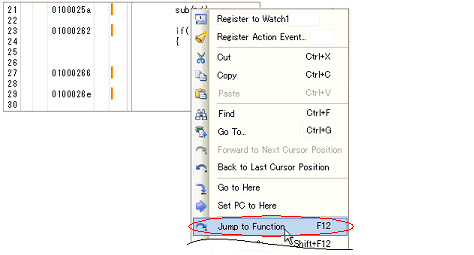When a source file is opened, it automatically recognizes the currently selected characters or the word at the caret position as the function name and jumps to the first executable line of the target function.
Select [Jump to Function] from the context menu after moving the caret to the target function on the source text.
When multiple statements are described in a line, a jump to an illegal location may be made. |
When a given character string does not fully specify the desired function, jumping may not be possible or the jump may actually be to a different function with the same name. |
Member functions in classes |
Functions defined in namespaces |
Template functions |

Note that this function is available only when the following conditions are satisfied for each specific build tool.
When [Yes(-Xcref)][CC-RH][CC-RX]/[Yes(-cref)][CC-RL] is specified with the [Output cross reference information] property of the build tool |
If functions with the same name exist, then the Jump to Function dialog box will be opened, and you can select the jump destination function. |
The target function is defined in a file that is specified as the first file in the [Download files] property in the [Download] category on the [Download File Settings] tab of the Property panel. In addition, the file includes the symbol information. |
Calling the target function from the file corresponding to the address of the program counter (PC). |
The target function resides in an active project. In case it is disconnected from the debug tool, a jump to a static function cannot be made. |
A file with the symbol informationNote is specified with the [Download files] property in the [Download] category on the [Download File Settings] tab of the Property panel. In case it is disconnected from the debug tool, the above file is specified as the first file in the [Download files] property. |